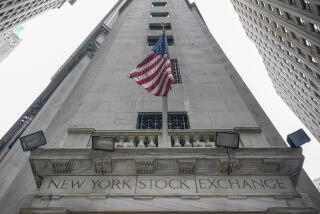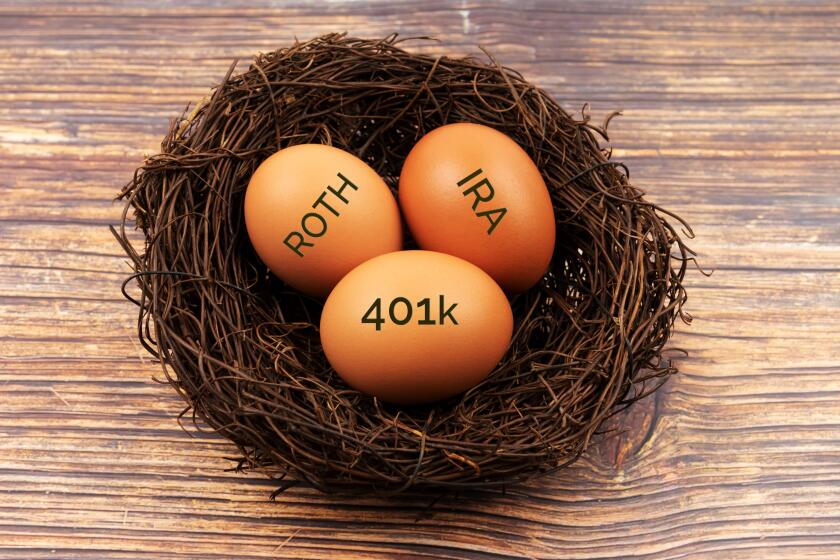Real Estate Jitters Sink S&L; Stocks : Thrifts: HomeFed closes down $8.25 a share, its lowest level in more than a year.
- Share via
Nervousness over real estate lending in California grew Wednesday as stocks of major thrifts tumbled and Moody’s Investors Service downgraded the debt of two major California banks.
Trading in HomeFed Corp. opened four hours late Wednesday on the New York Stock Exchange, off $7.50 a share from its Tuesday close as investors reacted negatively to the San Diego-based company’s disclosure Tuesday that non-performing assets of its HomeFed Bank unit grew by $81 million, or 14%, in May.
For the record:
12:00 a.m. June 15, 1990 For the Record
Los Angeles Times Friday June 15, 1990 San Diego County Edition Metro Part B Page 3 Column 2 Metro Desk 1 inches; 29 words Type of Material: Correction
HomeFed--Due to an editing error, a Thursday story in the business section incorrectly stated that HomeFed Corp.’s debt had been downgraded by Moody’s Investors Service. No such downgrading has taken place.
HomeFed shares closed down $8.25 a share at $25, their lowest price in more than a year. The drop, which translates to a $170-million reduction in HomeFed’s stock-market value, dragged down other California bank and S&L; stocks as well.
Great Western Financial in Beverly Hills, for example, closed down $1.625, at $18.875; H. F. Ahmanson, the Los Angeles-based parent of Home Savings, was down $1, to $21.25; CalFed in Los Angeles was down $1.875, at $19.50, and Golden West, the Oakland-based parent of World Savings, was off $1.875, to $19.50.
Analysts attributed the selloff to investor skittishness about the S&L; industry as a whole, as well as to fears that even healthy thrifts such as HomeFed are vulnerable to a downturn in the California real estate market.
“The market with HomeFed was unceremoniously reminded that California may have a softening in real estate prices,” said Peter Treadway, savings and loan analyst with Smith Barney, Harris Upham & Co.
Separately, Moody’s downgraded debt of both Wells Fargo & Co. and Security Pacific Corp., citing potential exposure to real estate problems and corporate buyout loans.
Both banks reacted angrily. Security Pacific Chief Executive Robert H. Smith, citing the Los Angeles-based company’s strong West Coast bank system and diverse earnings, said it “strongly disagrees” with the rating agency’s move.
Wells Fargo spokeswoman Kim Kellogg said the San Francisco-based company has “a 15-year track record of construction lending with the same management. We’ve been through these markets before.”
Wells Fargo’s stock dipped $2.375, to $81.625. Security Pacific’s stock fell 75 cents, closing at $40.375.
The magnitude of the HomeFed stock drop, resulting from a severe shortage of buyers at the market’s opening, also reflected what analysts described as a loss of investor confidence in HomeFed management. Two months ago, HomeFed officials were saying they hoped to reduce its nonperforming loans--credits more than 90 days delinquent or in foreclosure--to less than $400 million by the end of 1990.
But the bump in HomeFed’s bad loans brought total non-performing assets to $579 million, or 3.12% of the S&L;’s $18.2 billion in total assets. HomeFed, which discloses pertinent financial information on a monthly basis, disclosed last month that its bad loans had jumped 10% in April.
HomeFed said the worst may not be over. Based on preliminary results from a thorough review of its assets that began last month, HomeFed said it now expects its nonperforming loans to increase in June as well.
While few analysts question HomeFed’s financial stability--its capital is still substantially above minimum levels required by regulators--some said the disclosure has them worried about whether HomeFed has a grip on its problem loans.
“You’ve got several issues. One, a fundamental problem that commercial real estate in California is getting hit worse than we thought,” said Gary Gordon, an S&L; analyst with Paine Webber in New York. “Second, how could they say two months ago that bad loans would be down below $400 million by the end of the year and then they go up 25% in two months? And third, there is the issue of whether management really knows what is going on.”
Nancy Spady, a thrift analyst at Morgan Stanley in New York, said investors may be particularly skittish about HomeFed because it has a higher percentage of assets in commercial real estate loans and development projects than do other healthy thrifts and thus is more vulnerable to a downturn.
More to Read
Inside the business of entertainment
The Wide Shot brings you news, analysis and insights on everything from streaming wars to production — and what it all means for the future.
You may occasionally receive promotional content from the Los Angeles Times.










